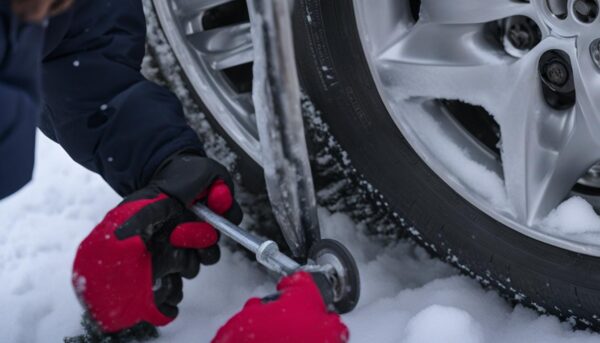Last Updated on 1 week
Enhancing Winter Safety with the Benefits of Snow Tires
Essential for any driver facing snowy or icy conditions, winter tires are engineered to enhance safety by providing improved grip and control during the coldest months. Key to their performance is the customized tread patterns, more profound than those of all-season and summer tires, including sophisticated sipes for biting into ice.
Unlike traditional tires that harden in freezing temperatures, winter tires remain flexible due to a unique tread rubber composition designed for the cold. This flexibility allows for better traction, acceleration, stopping, and cornering in winter conditions. Installing a complete set of snow tires ensures balanced vehicle handling and reduced risk of skids or slides, making the driving experience safer and more reliable when temperatures drop.
Key Takeaways:
- Winter tires offer improved grip and control in snowy and icy conditions.
- Specialized tread patterns and rubber compounds enhance traction in cold weather.
- The flexibility of winter tires allows for better acceleration, stopping, and cornering.
- Complete sets of snow tires provide balanced vehicle handling and reduced skid risk.
- Maintaining winter tires with proper care can lengthen their lifespan and effectiveness.
Understanding the Unique Design of Winter Tires
Winter tires stand apart due to their specific design elements aimed at tackling the harsh driving conditions of winter. Unlike all-season tires that stiffen, these tires feature a distinct tread rubber built for flexibility in low temperatures. They ensure substantial traction on snow and ice with deeper tread depths and specialized tread patterns containing numerous slots and sipes. These design features allow winter tires to dig deep into snow and slush, providing more control and helping to evacuate water and slush from the tire’s contact with the road, which is crucial for maintaining a grip on unpredictable winter surfaces.
Various snow tire brands are available in the market, each offering unique tread patterns at different price points, making it easy for consumers to find suitable snow tires for sale. Let’s look closer at the distinct design features of winter tires that make them the ideal choice for tackling snowy and icy conditions.
“Choosing the right winter tires is essentially a game-changer for drivers in cold climates. More than just thick rubber and deep tread patterns, winter tires are designed to optimize traction in the most slippery and treacherous conditions.”
- Deeper Tread Depths: Winter tires have deeper tread depths than all-season or summer tires. This additional depth allows them to dig into snow and slush, providing a firmer grip and more responsive handling.
- Specialized Tread Patterns: Winter tires feature unique tread patterns designed to increase traction on snowy and icy surfaces. These patterns often contain slots and sipes, which act as additional biting edges for better grip.
- Flexible Tread Rubber: The tread rubber in winter tires is formulated to remain flexible even in frigid temperatures. This flexibility allows the tires to maintain contact with the road better than all-season tires, which tend to stiffen as temperatures drop.
When selecting the right winter tires for your vehicle, exploring different snow tire brands and their offerings is essential. To help you make an informed decision, here’s a comparative table of some popular winter tire brands and their key features.
| Brand | Popular Model | Key Features |
|---|---|---|
| Bridgestone | Blizzak WS90 | Excellent grip on ice and snow, improved stopping distance, optimized tread pattern for better handling |
| Michelin | X-Ice Xi3 | Enhanced ice traction, quick slush and water evacuation, long-lasting performance |
| Goodyear | Ultra Grip Winter | Reliable snow and ice handling, improved braking, and enhanced traction on wet and dry roads. |
| Continental | VikingContact 7 | Superb grip on snow and ice, excellent wet handling, secure braking performance |
In conclusion, understanding the unique design of winter tires will help you make the best choice based on your specific driving needs and preferences. Remember the mentioned factors when selecting a winter tire, and you can be confident that you’ll be well-equipped to face challenging winter roads.
The Critical Role of Tread Rubber in Snow Tires
Winter tire performance relies heavily on the unique properties of its tread rubber composition. Unlike all-season or summer tires, winter tire tread rubber is designed to remain flexible at low temperatures. This flexibility is vital for maintaining grip on icy roads and dramatically enhances overall tire performance in winter.
How Tread Rubber Composition Changes in Winter Tires
The tread rubber compound undergoes significant modifications to cater to cold weather challenges. The unique rubber formulation in winter tires ensures they do not stiffen like all-season or summer tires, maintaining optimal traction for acceleration and stopping in frigid environments. This is achieved by incorporating more natural rubber and silica, which helps the tire hold its elasticity even at low temperatures.
“Winter tires remain flexible in low temperatures due to their unique tread rubber composition, ensuring optimal traction and control on icy roads.”
The Importance of Flexibility in Tread Rubber at Low Temperatures
The flexibility of tread rubber in winter tires is critical for maintaining grip on slippery surfaces such as snow and ice. The elastic nature of winter tire rubber allows it to conform to the texture of the road better, providing a larger contact area and consequently better traction than more complex, less flexible rubbers used in other tire types. Essentially, this flexibility ensures that the winter tire can:
- Remain supple at low temperatures, unlike all-season tires, which can become stiff and lose grip.
- Create a larger contact patch with the road surface for better traction and vehicle control.
- Efficiently evacuate snow and slush, reducing the risk of hydroplaning
| Tire Type | Flexibility of Tread Rubber | Performance in Cold Weather |
|---|---|---|
| Winter Tires | High | Optimal grip, traction, and braking performance on snow and ice |
| All-Season Tires | Low | Poor traction and braking performance on icy and snowy roads |
| Summer Tires | Very Low | Unsuitable for winter driving conditions |
When choosing the right tires for winter driving, it is essential to understand the benefits that winter tire tread rubber provides. Investing in high-quality snow tires will ensure optimal traction, control, and road safety during the cold winter.
Mastering Snow and Ice: The Tread Pattern Difference
When conquering snowy and icy roads, the tread pattern snow tires showcase is crucial to separating them from all-season and summer tires. Winter tires ensure better traction, handling, and control in challenging winter conditions. Among the essential features contributing to their superior performance are the snow tires’ tread depth and unique snow tire patterns.
The Role of Tread Depth in Snow Tires
Winter tires boast deeper tread depths compared to all-season and summer tires. This increased depth allows the tires to dig into the snow and slush, providing better grip and control on slippery surfaces. The deeper tread depth also enhances the tires’ ability to channel away water and slush from their contact patch. This dramatically reduces the risk of hydroplaning, contributing to safer driving experiences in winter conditions.
Slots and Sipes: The Secret to Improved Ice Traction
Another crucial aspect of winter tires is the presence of slots and sipes in their tread patterns. Sipes are small slits strategically placed throughout the tread pattern, which act as additional biting edges for an enhanced grip on ice. These intricate, zigzag-shaped cuts provide optimal ice traction, ensuring a firmer grip and improved handling.
“The comprehensive tread design of snow tires allows for better channeling of water and slush, providing enhanced control and the ability to navigate through snow and icy conditions with greater confidence.”
- Deeper tread depth: Allows for improved snow and slush traction.
- Slots: Help evacuate water, reducing the risk of hydroplaning.
- Sipes: Enhance grip on ice by providing additional biting edges.
In conclusion, winter tires’ distinct tread pattern designs significantly deliver enhanced performance during snowy and icy conditions. The deeper tread depth, slots, and sipes work together to ensure better handling, traction, and control on slippery roads, making winter tires a must-have for drivers facing cold weather challenges.
Winter Tires vs. All-Season Tires: A Comprehensive Comparison

When selecting the right tires for your vehicle, the debate between winter and all-season tires is standard. Both types of tires have their distinct advantages and disadvantages. Still, the choice ultimately depends on the specific needs of the driver and the typical driving conditions they will encounter. In this section, we will look closer at the debate of winter tires vs all-season tires and analyze why winter tires outperform all-season tires in cold conditions.
Reasons Winter Tires Outperform All-Season Tires in the Cold
1. Enhanced Traction at Lower Temperatures: The specialized rubber compounds used in winter tires are designed to remain flexible in extremely low temperatures, allowing them to maintain a better grip on slippery surfaces. In contrast, all-season tires are more likely to stiffen in cold conditions, reducing their overall performance and safety margins.
2. Deeper Tread Depths: Winter tires boast deeper tread depths than their all-season counterparts. This design feature allows winter tires to dig into snow and slush effectively, improving traction and control. All-season tires lack the same depth, which can limit their performance in challenging winter conditions.
3. Unique Tread Patterns: Winter tires are specifically designed with unique tread patterns for optimized performance on snow and ice. With increased slots and sipes, these patterns help enhance grip, channel water, and slush away from the tire’s contact area with the road. Conversely, all-season tires are built to provide an acceptable level of performance in various weather conditions. Still, their tread patterns cannot match the specialized version of winter tires in extreme conditions.
Winter tires offer enhanced traction, stopping power, and cornering stability on snow and ice, while all-season tires lack the same degree of flexibility, tread depth, and biting edges, making winter tires a superior choice in extreme weather conditions.
To better illustrate the differences in performance, the following table compares various features of winter tires and all-season tires:
| Feature | Winter Tires | All-Season Tires |
|---|---|---|
| Rubber Compound | Specialized rubber designed to stay flexible at low temperatures | Standard rubber compounds are more prone to hardening in cold conditions |
| Tread Depth | Deeper tread depths for improved snow and slush management | Shallower tread depths are less effective in snow and slush |
| Tread Pattern | Uniquely designed patterns with increased slots and sipes for optimal grip on snow and ice | General-purpose tread patterns not explicitly optimized for winter conditions |
| Performance in Cold Conditions | Superior traction, stopping power, and cornering stability | Performances decline as conditions become more demanding |
In conclusion, while all-season tires offer a reasonable level of performance in various weather conditions, their limitations become more apparent in extreme cold and winter conditions. Regarding snow tires’ performance, their specialized design and features far outperform all-season tires, making them safer and more reliable for drivers facing harsh winter conditions.
The Case for Four: Why Full Sets of Snow Tires Are Essential
Utilizing a complete set of winter tires is crucial for maintaining balanced handling and stability on winter roads. Mounting snow tires on all four wheels provides uniform traction, preventing the potential for a rear-wheel skid in front-wheel-drive vehicles and enhancing steering control in rear-wheel-drive vehicles.
This cohesive approach minimizes the likelihood of accidents by ensuring that all tires have an equal ability to grip the road, providing a significant safety advantage over using only two winter tires. In addition to a complete set of snow tires, some drivers may also consider tire chains for snow as an added safety measure, especially for more extreme winter conditions.
A study by the Tire and Rubber Association of Canada found that equipping a vehicle with four winter tires reduced the stopping distance on ice by up to 25% compared to using only two winter tires.
When buying winter tires, it’s essential to ensure you’re purchasing a complete set to maximize your vehicle’s safety and performance during winter months. To help make the selection process easier, bear in mind the following considerations:
- Choose the right size of winter tires to match the manufacturer’s recommended specifications for your vehicle.
- Research and compare snow tire brands, reading reviews and gathering information on their performance in real-life winter conditions.
- Consider additional safety equipment, such as tire chains for snow, particularly if you regularly encounter severe winter conditions.
By investing in a complete set of winter tires, drivers can enjoy a safer and more controlled driving experience during the harsh winter months. The added traction and stability are invaluable when navigating through snow, ice, and slush, ultimately contributing to a safer, more enjoyable cold-weather driving experience.
Preparation Tips: When to Switch to Winter Tires

Transitioning to winter tires should occur before the onset of winter weather for optimal safety. A practical guideline suggests it’s time to switch if the outside temperature consistently allows you to see your breath. Installing winter tires on their wheels ahead of time can expedite this process, making seasonal changeovers quicker and more convenient.
Timing Your Tire Switch for Optimal Safety
Choosing the right winter tire switch timing ensures optimal safety on snow and ice. While the ideal time to switch varies depending on your location and local climate patterns, swapping over when temperatures routinely drop below 45°F (7°C) is a general rule of thumb. By making the switch at this suggested time, you help maximize the performance and effectiveness of your winter tires during the colder months.
Advantages of Having a Dedicated Set of Wheels for Winter Tires
There are significant benefits to having winter tires mounted on a separate set of wheels. This strategy simplifies the seasonal tire swap, reducing waiting times at auto shops and minimizing the hassle of remounting tires each year. Using dedicated wheels for winter tires can provide the following advantages:
- Easier and faster seasonal changeovers
- Less wear on the tire bead from frequent mounting and dismounting
- Opportunity to choose a more suitable wheel material for winter conditions
- Reduced risk of damage to wheels or tires during changeovers
Especially for vehicles equipped with a Tire Pressure Monitoring System, having a set of wheels specifically for winter tires ensures that sensors are correctly calibrated and facilitates a more straightforward changeover process.
“By having a dedicated set of wheels for your winter tires, you not only make the changeover process more efficient, but you also help to prolong the life of your tires and wheels.”
| Aspect | Regular Tire Changeover | Using Dedicated Wheels for Winter Tires |
|---|---|---|
| Convenience | Requires mounting and dismounting each season | Easier changeovers with tires already mounted on wheels |
| Efficiency | Longer waiting times at auto shops | Quicker changes with less reliance on auto shops |
| Wheel Material Choices | Limited to one set of wheels for both winter and all-season tires | Option to choose different wheel materials for better winter performance |
| Tire & Wheel Lifespan | Increased wear from mounting and dismounting | Reduced wear and potential damage to tires and wheels |
Switching to winter tires appropriately and investing in dedicated wheels maximize safety and efficiency during the colder months. By following these tips, you can confidently navigate winter road conditions and ensure your and your vehicle’s well-being.
Protecting Your Investment: The Right Way to Maintain Winter Tires
Maintaining winter tires correctly protects your investment and ensures their longevity. Proper tire maintenance includes usage, regular inspections, and storage. Following these best practices helps prevent premature wear and tear of your winter tires and makes them last longer, protecting your investment in the long run.
- Usage
- Regular inspections
- Storage
First and foremost, it is crucial to use winter tires only during the appropriate season. Premature wear can occur if they are driven extensively in warmer conditions. Using your winter tires in colder months ensures that they operate in the temperatures designed for and helps prolong their lifespan.
Regularly inspecting your winter tires is a vital part of snow tires maintenance. Before the start of the winter season, check the tread depth to ensure it meets the minimum standard for effective snow performance. A simple way to gauge adequate tread depth is to use the “quarter test.” Insert a quarter into the tire tread with George Washington’s head facing down – if the track still covers any part of his head, your tires are good to go for the winter season. This test should be done on multiple points of the tire to ensure even wear.
Use the “quarter test” to determine if your winter tires still have adequate tread depth for optimal performance.
Lastly, proper long-term tire care involves safely storing them when not used. Tires should be stored in a cool, dry place protected from sunlight, heat, and chemicals. Conveniently, many tire retailers and service centers offer seasonal tire storage services to ensure the best possible conditions for preserving your winter tires. To store your tires correctly, follow these guidelines:
- Clean your tires thoroughly and remove any dirt, rocks, or debris.
- Inspect the tires for any signs of damage, such as punctures or worn areas.
- Place your tires in airtight plastic bags and try to remove as much air as possible before sealing them.
- Store tires stacked on their sides and rotate their positions periodically to avoid any potential deformation.
- Avoid storage areas with excessive heat, chemicals, or direct sunlight exposure.
| Usage | Use winter tires only during the appropriate season |
|---|---|
| Regular inspections | Check tread depth before the winter season and monitor for even wear |
| Storage | Store tires in a cool, dry place, protected from sunlight, heat, and chemicals |
By following these guidelines, you can ensure your winter tires’ long-term care and maintenance, making them last longer and protecting your investment while providing safer driving conditions during colder months.
Conclusion
As drivers, making a well-informed decision about snow tires can lead to safer and more enjoyable winter journeys. Familiarizing oneself with the unique design of winter tires proves beneficial in comprehending the necessity for complete sets, the appropriate timing for installation, and maintenance practices, which all significantly impact driving safety in cold weather.
Additionally, it’s important to consider legal requirements and the advantages of heightened vehicle control, potential long-term savings, and even the resale value that investing in snow tires can bring to a vehicle. The market offers a variety of options for every driver, underlining the importance of choosing the right snow tires to maximize their benefits.
In conclusion, anyone committed to navigating the challenges of winter driving confidently can make the most of their experience by selecting the best snow tires for their specific needs and conditions. With a comprehensive understanding of the factors at play, investing in the correct set of winter tires will improve safety on snow-covered roads and provide peace of mind throughout the cold season.
FAQ
What makes winter tires different from all-season or summer tires?
Winter tires are specifically designed for cold weather conditions. They feature unique tread rubber compounds that remain flexible in low temperatures, deeper tread depths, and specialized tread patterns with numerous slots and sipes for enhanced grip on snow and ice. All these design elements improve traction, stopping power, and cornering stability during winter.
Why is the flexibility of tread rubber important for winter tires?
The flexibility of tread rubber is essential for maintaining grip on icy roads. Winter tire rubber compounds are formulated to stay flexible in low temperatures, allowing them to conform better to the road surface and provide a larger contact area. This improves traction, acceleration, and stopping power on snowy and icy surfaces compared to all-season or summer tires.
Should I use a complete set of winter tires or just two?
Using a complete set of winter tires is crucial to maintain balanced handling and stability on winter roads. Mounting snow tires on all four wheels ensures uniform traction and prevents the potential for skids or slides, enhancing steering control and minimizing the likelihood of accidents.
When should I switch to winter tires?
For optimal safety, switching to winter tires before winter weather is advisable. A general guideline is that it’s time to make the switch if the outside temperature consistently allows you to see your breath. Installing winter tires on their wheels ahead of time can make seasonal changeovers quicker and more convenient.
What are the advantages of having a dedicated set of wheels for winter tires?
Having winter tires mounted on separate wheels simplifies the seasonal tire swap, reducing waiting times at auto shops and minimizing the hassle of remounting tires yearly. For vehicles equipped with a Tire Pressure Monitoring System, having dedicated wheels for winter tires ensures that sensors are correctly calibrated and facilitates a more straightforward changeover process.
How can I properly maintain my winter tires?
Proper maintenance of winter tires includes using them only during the appropriate season, regularly inspecting their tread depth, and storing them in a cool, dry place when not in use. This ensures their longevity and protects your investment.










